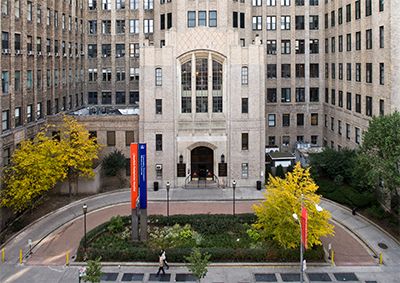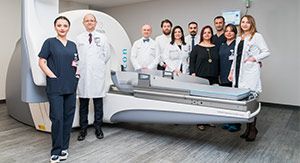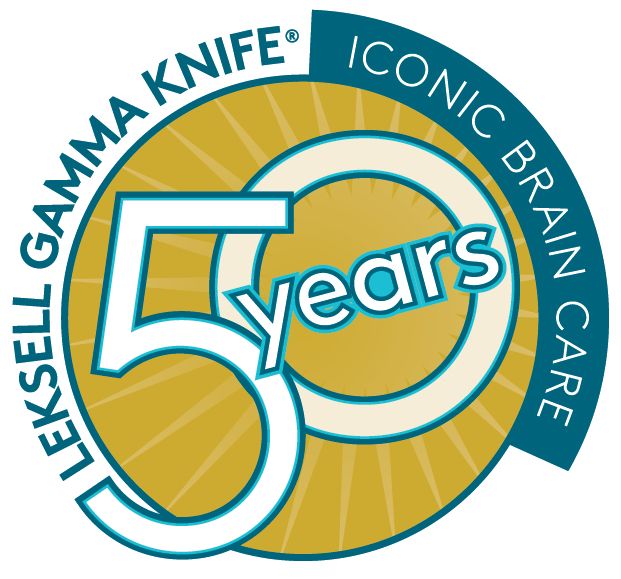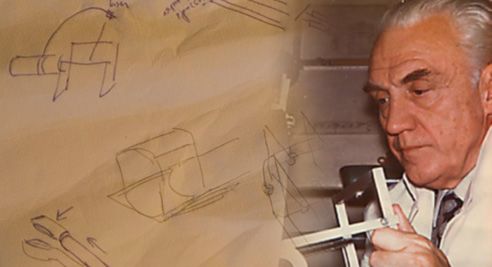Columbia University treats 5,000th Gamma Knife patient

Matthew Colonna, a New York policeman, is treated for vestibular schwannoma that plagued him with vertigo and threatened his hearing
Leksell Gamma Knife® systems began treating patients in 1968, seven years before Matthew Colonna was born. However, unlike many technologies introduced in the 1960’s which are now obsolete, cassette tapes and Polaroid cameras, for instance, Gamma Knife radiosurgery – in its 50th year and sixth generation – continues to be a modern, innovative technology that annually treats more than 80,000 patients suffering from intracranial tumors and other disorders (see sidebar). Matthew, today a 43-year-old Suffolk County, New York police officer, became one of those to benefit from a technology that predates him by nearly a decade.
Matthew’s story begins in 2015, when he suffered from a transient spell of vertigo that sent him to the hospital.
“I couldn’t keep anything down. I couldn’t walk, I couldn’t move, I couldn’t do anything in the room because of the spinning.”
“I couldn’t keep anything down,” he recalls. “I couldn’t walk, I couldn’t move, I couldn’t do anything in the room because of the spinning. Then nothing for two years. In January 2017, I woke up from a dead sleep with severe vertigo. The room was spinning and I could barely walk. I was prescribed Antivert® [Meclizine] to prevent the room from spinning or if I were dizzy it would stop me from becoming sick from it.”
Only another month would pass before vertigo struck again, just as Matthew was preparing to leave for vacation. Although self-administering Antivert resolved the symptoms, after his vacation the married father of three began having vertigo spells on virtually a monthly basis.
“I’m thinking this is getting kind of weird,” he says. “I went to an ENT doctor for a positional vertigo test, which was negative. However, I found that I had moderate to severe hearing loss in my left ear, along with tinnitus* that had been going on since January 2017. To rule out a tumor, the ENT doctor sent me for an MRI even though he seemed confident there wouldn’t be one. I called him back and he told me I had a tumor – a vestibular schwannoma.”
Matthew’s tumor was a 4 mm lesion – less than half the dimensions of a sugar cube – but eradicating the tiny invader was imperative.
Columbia calling
After a brief period of research for a neurosurgeon to consult with him on his September 2017 diagnosis, a family friend of Matthew’s recommended Columbia University neurosurgeon Michael B. Sisti, MD, Co-Director of the institutions Gamma Knife Center, along with Columbia radiation oncologist Tony J. Wang, MD.

Drs. Wang and Sisti explained Matthew’s three treatment options: 1.) He could have no procedure done, in which case he would eventually completely lose hearing in his left ear, whereupon it could ultimately press up against his brain stem and lead to a slew of other problems over time. 2.) Matthew could undergo brain surgery, but Dr. Sisti warned that this alternative would guarantee hearing loss, and his vertigo would persist because cutting the nerve abruptly wouldn’t give his body time to react and compensate by transitioning to the other vestibular nerve. 3.) Gamma Knife radiosurgery.
“Drs. Sisti and Wang said that Gamma Knife radiosurgery was an attractive option because it’s very precise and precision would be important due to the tumor’s proximity to the cochlea.”
“A constant state of vertigo sounded horrific with the surgical option, so that was out of the question and doing nothing was obviously also unacceptable,” he says. “Drs. Sisti and Wang said that Gamma Knife radiosurgery was an attractive option because it’s very precise and precision would be important due to the tumor’s proximity to the cochlea.”
“They said if they could get the radiation to go only into the tumor, the dose will result in the tumor dying slowly,” Matthew adds. “That would be important because it would give my body time to compensate from the lack of input from the irradiated vestibular nerve by going over to the other nerve. That would mean I wouldn’t have severe vertigo and my hearing would be preserved, which in my job as a police officer is critical. I can’t lose my hearing.”
18 minutes that changed Matthew’s world
Matthew’s interaction with Columbia’s Gamma Knife Center in late 2017 coincided with two significant milestones; first, the clinic was on the cusp of its 20th year of patient treatments and second, Gamma Knife Center staff were about to treat their 5,000th patient – none other than Matthew Colonna.
Matthew’s procedure would be done with Columbia’s Leksell Gamma Knife® Icon™, Elekta’s latest generation intracranial radiosurgery system. Since 1998, the Center had employed a Gamma Knife B unit and a Leksell Gamma Knife® Perfexion™ system. The clinic’s Icon system, which became clinically operational on April 11, 2017, integrates advanced imaging and immobilization technology that enables Gamma Knife radiosurgery to be conducted without a rigid headframe and spread out over several sessions safely and efficiently. Fractionated (i.e., multi-session) frameless Gamma Knife radiosurgery with a mask is sometimes used for treating large tumors.
In Matthew’s case, Drs. Sisti and Wang preferred to use the headframe due to the vestibular schwannoma’s tiny size and close proximity to the cochlea.
“The frame completely immobilized my head so that I couldn’t so much as twitch,” he recalls. “This would be a single, high dose procedure so they needed precision. They also gave me Ativan [Lorazepam] to calm me down.”
Matthew was treated on October 16, 2017, going down in history as Columbia’s 5,000th Gamma Knife patient.
“The whole procedure took just 18 minutes – I mean the radiosurgery prep took longer.”

“The whole procedure took just 18 minutes – I mean the radiosurgery prep took longer,” he remembers. “They removed the frame and put Band-Aids on the spots where it was attached and they had me sit for 15 minutes after that to make sure I wasn’t going to have a vertigo issue. I didn’t, so I went home.”
Matthew admits to some mild tiredness for a couple of days post-operatively, but by the fourth day, he says he felt fine.
“I’ve been at 100 percent since then – the vertigo is gone, I haven’t had any side effects and it seems that my hearing is the same as it was pre-Gamma Knife radiosurgery,” Matthew reports. “The doctor doesn’t want to see me again until a full year passes, so I need to schedule an appointment for October 2018.”
Regarding his status as a milestone patient for Columbia’s Gamma Knife Center, Matthew admits he was somewhat detached from the significance of the event.
“I guess it was fantastic for them,” he smiles as he recalls neurosurgery and radiation oncology department personnel gathering excitedly. “I mean, I was just trying to get better, so I was just going along for the ride. It was definitely amusing and it kept my spirits up. It seemed like the whole department was there, along with people that apparently were in the Gamma Knife Center since the beginning of the program.”
Today, Matthew is a big believer in Gamma Knife radiosurgery, particularly for those with a vestibular schwannoma.
“I would definitely recommend Gamma Knife to anyone who has what I had…hearing is just too important to not look for ways to preserve it.”
“I would definitely recommend Gamma Knife to anyone who has what I had,” he says. “Hearing is just too important to not look for ways to preserve it. There are several ways to treat a vestibular schwannoma, but only Gamma Knife offered the potential to save my hearing.”
*Unresolved post-Gamma Knife radiosurgery but determined to be unrelated to the tumor
50 years and over 1 million patients later, Gamma Knife radiosurgery remains the gold standard
The first patient to have Leksell Gamma Knife® stereotactic radiosurgery in a clinical setting had his procedure to treat a pituitary adenoma at Stockholm’s Sophiahemmet Hospital on January 27, 1968. By 2018 – Gamma Knife® radiosurgery’s 50th year – a staggering 1.1 million people scattered over the globe had undergone Gamma Knife surgery. Today, 330 Gamma Knife units, distributed among 54 countries, combine to treat over 80,000 new patients each year.
Combining gentleness with gold standard precision
The undisputed gold standard for the radiosurgical treatment of intracranial disorders, Gamma Knife radiosurgery is a gentler alternative to traditional brain surgery and whole brain radiation therapy for illnesses such as metastatic disease, which is cancer that has travelled to the brain from elsewhere in the body. With pinpoint accuracy, Leksell Gamma Knife delivers up to thousands of low-intensity radiation beams to one or more targets in a single or sometimes multiple sessions.
Leksell Gamma Knife became a commercial product in 1987 with the introduction of the model U, followed in 1992 with the B version. Ongoing hardware and software improvements resulted in models C and 4C in 1998 and 2004. In 2006, Elekta introduced Leksell Gamma Knife® Perfexion™, which dramatically streamlined workflow and expanded the treatable volume through an automated, multi-source collimator.
Iconic brain care
The most impactful upgrade to Gamma Knife technology is represented by Leksell Gamma Knife® Icon™, the platform’s sixth generation introduced in 2015. Icon integrates advanced motion management, frameless head fixation and cone beam CT (CBCT) tumor targeting capabilities. With these innovations, physicians can now practically perform frameless Gamma Knife radiosurgery and, in select cases, easily spread the procedure out over multiple sessions (i.e., fractionation).
“As remarkable as the Gamma Knife technology’s first 50 years has been,” says Elekta President and CEO, Richard Hausmann, “the next half-century has the potential to transcend anything we can presently conceive of for this modality, allowing far greater numbers of patients to have access to this gentle and clinically time-proven surgical method.”





